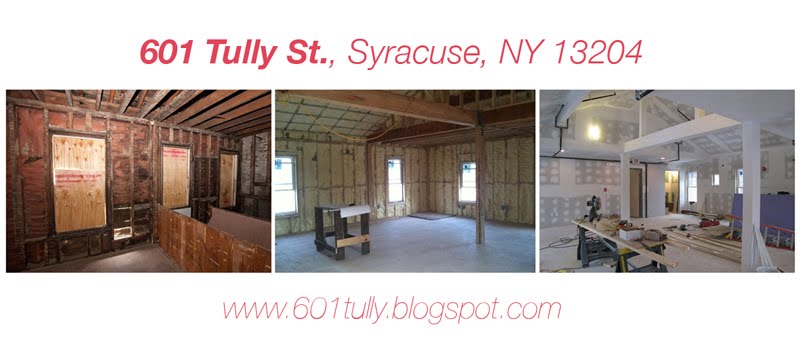About 601 Tully
Check out our new website! 601Tully.syr.edu
601 Tully is a center for engaged practice in Syracuse, NY developed by artist and professor Marion Wilson with a rotating collaborative team of 54 students and neighbors and Anda French of French 2Design. It's a site for meaningful exchange between artists, community members, and scholars in the co-production of culture.
601 Tully includes a contemporary art space, a public events space, a bookstore, a teaching garden, and Recess Cafe West.
In 2009, Wilson purchased the condemned two-story home and local drug hub, and throughout five semesters, Wilson's design/build class re-zoned, designed, renovated and now sustains the physical and programmatic aspects of 601 Tully. The collaborative team has consisted of artists, architects, environmentalists, Fowler High School students, Green Train Workforce, neighbors, and the occasional passerby.
601 Tully is made possible by the generous support of the Syracuse University School of Education, The Kauffman Foundation, The Near West Side Initiative, Imagining America, Home HeadQuarters Inc., Say Yes to Education, and National Grid.
Find us on Facebook!
Monday, November 16, 2009
Quotes think about from Miwon Kwon's One Place After Another
- Henry Moore, pg. 63
"...entry [into a work] is facilitated when the public percieves the work as performing some useful task, whether it is simply that of shade and seating, or something even remotely associated with the sense of leisure. To be guided through space in a way that rewards the passer-by is of prime value to the public."
- Janet Kardon, from the catalogue essay for the 1980 exhibition "Urban Encounters: Art Architecture Audience", pg. 66
"...site specificity has been both a means to move beyond sculpture and simultaneously a "medium" through which to serve its 'internal necessity'"
- Miwon Kwon, pg. 78
"...Tilted Arc's removal was a discrediting of a perticular model of public art - or a particular model of site specificity as I would insist - one without obvious utilitarian payoffs, one that critically questions rather than promotes the fantasies of public space as a unified totality without conflicts or difference... the sculpture's removal from Federal Plaza, when viewed as a triumphal rejection of "high art" by "the people" also signified an implicit validation of the community oriented approach to public art... The controversy [itself cast] as an exemplary instance of "the conventions of artistic expression... com[ing] into conflict with public opinion."
- Miwon Kwon, pp. 79-82
"...while there may be disagreements among different groups over the specifics, the dominant priniciple or operative basis of community-based site specificity is the presumption of a unity of identity between the artist and the community and between the community and the art work. Indeed, the commonality of this belief is the source of [disagreements in communities]...emphasis on the social stems from the belief that the meaning or value of the art work does not reside in the object itself but is accrued over time through the interaction between the artist and the community. This interaction is considered to be integral to the art work and equal to the significance (it may even be thought of as constituting the art work)..."becoming one," no matter how temporary is presumed to be a prerequisit for an artist to be able to speak with, for, and as a legitimate representative or member of the community. "
- Miwon Kwon, pp. 93-94
"...a central objective of community-based site specificity is the creation of a work in which members of a community - as simultaneously view/spectator, audience, public, and referential subject - will see and recognize themselves in the work, not so much in the sense of being ctitically implicated but of being affirmatively pictured or validated... rather than art works that are seperated or detached from the space of the audience, which reinforce social alienation and disaffection, once should sponsor works that reassure the viewing subject with something familiar and known... Therefore, the task of "reassur[ing] the viewer with an easily shared idea or subject is best accomplished when the idea or subject of the art work is determined by the community or better yet if is the community itself in some way."
- Miwon Kwon, pp. 95-96
"The investment of labor would seem to secure the participants' sense of identification with "the work" not through an iconic or mimetic identification but through the recognition of its own labor in the creation of, or becoming of, 'the work.'"
-Miwon Kwon, pp. 96-97
"A culturally fortified subject, rendered whole and unalienated through an encounter or involvement with an art work, is imagined to be a politcally empowered social subject with opportunity (afforded by the art project) and capacity (understood as innate) for artistic self-representation (= political self determination)."
- Miwon Kwon, pg. 97

No comments:
Post a Comment